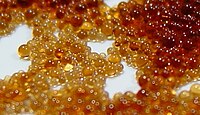
Photo from wikipedia
Studying the restructuring behavior of doped catalyst materials under electrochemical reaction conditions is important for understanding the structure–property relationships and for developing design principles for better catalysts. As a well-known… Click to show full abstract
Studying the restructuring behavior of doped catalyst materials under electrochemical reaction conditions is important for understanding the structure–property relationships and for developing design principles for better catalysts. As a well-known catalyst for both the cathode (H2 evolution reaction, HER) and anode (O2 evolution reaction, OER) reactions of water electrolysis, CoP can be made even more active by cationic or anionic substitution. However, the dependence of catalytic reactivity on substitutional doping has not been sufficiently understood in the context of restructuring under working conditions. In this work, cation (Fe)- and anion (S)-substituted CoP nanoparticles are synthesized, and their surface oxidation under ambient conditions and restructuring under HER and OER conditions are investigated. For Fe0.5Co0.5P, the Fe substituents are more easily oxidized than Co in the air; they are also more difficult to reduce under HER conditions in alkaline electrolyte, and the remaining Fe–OH speci...
Journal Title: ACS Catalysis
Year Published: 2019
Link to full text (if available)
Share on Social Media: Sign Up to like & get
recommendations!